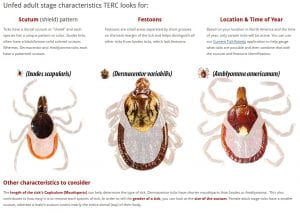The time of the falling leaves has come again. Once more in our morning walk we tread upon carpets of gold and crimson, of brown and bronze, woven by the winds or the rains out of these delicate textures while we slept. – John Burroughs
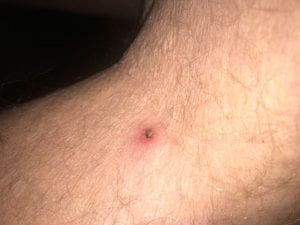
The time has also come again for blacklegged tick adults to look for their last blood meal to fuel the mating process. (To be specific, it’s time for the adult females to secure that last blood meal. It’s time for the adult males to secure a female.) And it’s time for requests such as this one, “I was wondering if you could ID this tick that I pulled off of myself and give me any tips on what diseases this variety tends to carry and transmit.”
First, let’s be clear that the information we provide about tick-borne diseases is restricted to what pathogens are carried by what tick species and how they are transmitted. It is beyond the scope of our roles as IPM Educators to discuss diagnosis, symptoms, and treatment. (For this information, we refer you to the Center for Disease Control and Prevention’s Tickborne Diseases of the United States page.) We will, however, provide you with information you can give your health care professional to help make an informed decision.
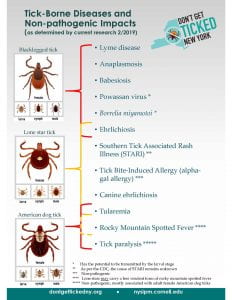
Tick-borne diseases
The easiest part of the request was what disease pathogens are carried by what ticks. The poster to the right shows what disease pathogens can be transmitted by the three ticks of greatest human concern in NY, the blacklegged tick, dog tick, and lone star tick. You can download and print it out and then go to the next step – identification.
Identifying ticks
Each species, life stage, and, for adults, whether it is a male versus female have different color patterns. The length of the mouthparts vary between ticks. They have festively named festoons which can also help with ID. As ticks are freakishly small, and we are looking at even smaller parts of their body, it is handy to have a magnifying lens, a good smartphone camera and a steady hand, or, better yet, a microscope. Don’t have one? There are options for having someone identify the tick for you. They include:
- Most County Cornell Cooperative Extension offices
- Cornell University Insect Diagnostic Laboratory
- Tick Identification at TickEncounter Resource Center
- The Tick App – a citizen science project with a free smartphone app collecting information on how and where people are becoming exposed to ticks
If you want to give identification a go, the TickEncounter Resource Center has an excellent guide highlighting the scutum, festoons, and life history. Life history? Yes! As temperatures drop, so does the activity of lone star, dog, and the newly discovered Asian longhorned tick, increasing the odds that the attached tick will be a blacklegged tick. And the active blacklegged ticks are most likely to be adults. Life history should only be used as a clue, however. Ticks don’t read the books and every life stage of the blacklegged tick has been found throughout the year.
What’s the risk?
A question you will likely be asked when reporting a tick is, “How long was the tick attached?”. In my honest opinion, this is a rather silly question. Ticks are very, very good at not being noticed. They want to stick around for up to a week feeding. To help deter detection, they release antihistamines and painkillers in their saliva. And, perhaps more importantly, none of us want to admit to ourselves that a tick was feeding on our blood for days. It’s a hard psychological pill to swallow. There is also some question in the medical literature about the time required for transmission of the bacteria that causes Lyme disease. Especially if the tick was removed improperly. (We covered safe removal of attached ticks in the blog post It’s tick season. Put away the matches and YouTube video How to remove a tick.) And we know Powassan virus can be transmitted in a matter of minutes. But the question will still likely be asked.
The answer? Take another look at that tick and refer to TickEncounter who has helpfully created charts showing the growth of ticks as they feed.
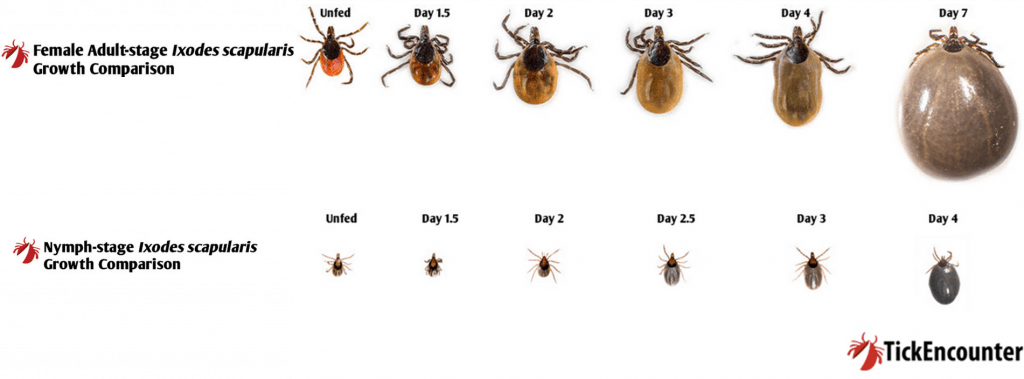
I have found this chart particularly useful when people swear the tick was on them for only a few hours. Having an estimate of the attached time is helpful information for your physician. Take your printed Tick-Borne Diseases and Non-Pathogenic Impacts sheet, circle the identified species, write down the estimated time of attachment, and consult with your health care professional.
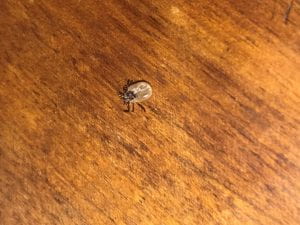
And now back to the original request: “I was wondering if you could ID this tick that I pulled off of myself and give me any tips on what diseases this variety tends to carry and transmit.”. The submitted picture is included to the right. (You can click on it to make it bigger.) Before reading on, what is your identification?
…
…
…
…
…
…
This looks like an adult blacklegged tick which was attached for 2 to 3 days, which is within the time frame that pathogens carried by the tick could have been transmitted. I recommended bringing in the tick for a more certain identification.
One last question often asked – “Should I get the tick tested?”
We follow the CDC recommendation of not having the tick tested for diagnostic purposes. The reasons include:
- Positive results showing that the tick contains a disease-causing organism do not necessarily mean that you have been infected.
- Negative results can lead to false assurance. You may have been unknowingly bitten by a different tick that was infected.
- If you have been infected, you will probably develop symptoms before results of the tick test are available. If you do become ill, you should not wait for tick testing results before beginning appropriate treatment.
Having said that, the Thangamani Lab in the SUNY Upstate Medical University is investigating the geographic expansion of ticks and tick-borne diseases in New York. They are conducting free tick testing for research purposes. Please consider contributing to this citizen science project and visit the website for directions on how to submit your tick.

And finally…
If you don’t get bitten by a tick, you don’t need to go through this process. Our Don’t Get Ticked NY campaign provides you with the information you need to protect yourself from the risk of tick-borne diseases. Check out How Do I Protect Myself From Ticks? before your next trip outdoors.
Let’s stay safe out there as we enjoy the beautiful fall colors.
